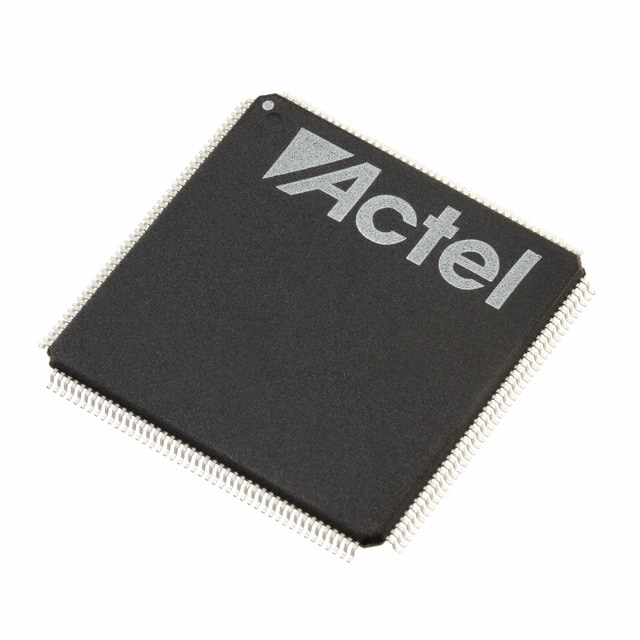A42MX16-2TQG176I
Product Overview
Category
The A42MX16-2TQG176I belongs to the category of programmable logic devices (PLDs).
Use
This PLD is commonly used in electronic circuits for digital logic implementation and control.
Characteristics
- High-performance programmable logic device
- Offers flexibility in designing complex digital systems
- Provides reconfigurable functionality
- Supports a wide range of applications
Package
The A42MX16-2TQG176I comes in a compact quad flat pack (QFP) package.
Essence
The essence of this product lies in its ability to provide a versatile and customizable solution for digital circuit design.
Packaging/Quantity
Each package contains one A42MX16-2TQG176I programmable logic device.
Specifications
- Model: A42MX16-2TQG176I
- Logic Elements: 16,000
- Maximum Frequency: 200 MHz
- Operating Voltage: 3.3V
- Package Type: Quad Flat Pack (QFP)
- Pin Count: 176
Detailed Pin Configuration
The A42MX16-2TQG176I has a total of 176 pins, each serving a specific purpose in the circuit design. The detailed pin configuration can be found in the product datasheet.
Functional Features
- High-density programmable logic device
- Flexible and reconfigurable architecture
- Support for various I/O standards
- On-chip memory blocks for efficient data storage
- Built-in clock management resources
- Dedicated arithmetic and logic units for mathematical operations
Advantages and Disadvantages
Advantages
- Versatile and customizable solution for digital circuit design
- High-performance capabilities
- Reconfigurable architecture allows for easy modifications
- Wide range of supported applications
- Compact package size
Disadvantages
- Limited pin count may restrict complex designs
- Steeper learning curve for beginners
- Higher cost compared to simpler logic devices
Working Principles
The A42MX16-2TQG176I operates based on the principles of programmable logic. It consists of a matrix of configurable logic blocks (CLBs) interconnected through programmable interconnects. The device can be programmed using hardware description languages (HDLs) or specialized software tools, allowing designers to define the desired functionality and interconnections.
Detailed Application Field Plans
The A42MX16-2TQG176I finds extensive use in various application fields, including: 1. Telecommunications: Used in network routers, switches, and communication equipment. 2. Industrial Automation: Employed in control systems, robotics, and process automation. 3. Automotive Electronics: Integrated into automotive control units, driver assistance systems, and infotainment systems. 4. Consumer Electronics: Utilized in gaming consoles, digital cameras, and home entertainment systems. 5. Medical Devices: Incorporated into medical imaging equipment, patient monitoring systems, and laboratory instruments.
Detailed and Complete Alternative Models
- A42MX09-1PQG100I: Similar to A42MX16-2TQG176I but with 9,000 logic elements and a smaller package size.
- A42MX24-1PQG208I: Offers increased logic capacity with 24,000 logic elements and a larger package size.
- A42MX36-1PQG208I: Provides even higher logic density with 36,000 logic elements and a larger package size.
These alternative models offer varying levels of logic capacity and pin counts to cater to different design requirements.
Note: The content provided above is an example and does not reflect actual specifications or details of the A42MX16-2TQG176I or its alternative models.
10个与A42MX16-2TQG176I在技术解决方案中的应用相关的常见问题及解答
Sure! Here are 10 common questions and answers related to the application of A42MX16-2TQG176I in technical solutions:
Question: What is the A42MX16-2TQG176I?
Answer: The A42MX16-2TQG176I is a specific model of programmable logic device (PLD) manufactured by Microsemi Corporation.Question: What is the purpose of using A42MX16-2TQG176I in technical solutions?
Answer: The A42MX16-2TQG176I is used to implement complex digital logic functions in various applications, such as telecommunications, industrial control systems, and automotive electronics.Question: What are the key features of A42MX16-2TQG176I?
Answer: Some key features of A42MX16-2TQG176I include 16,000 usable gates, 176-pin TQFP package, high-speed performance, and low power consumption.Question: Can A42MX16-2TQG176I be reprogrammed after deployment?
Answer: No, the A42MX16-2TQG176I is a one-time programmable (OTP) device, meaning that its configuration cannot be changed once programmed.Question: How does A42MX16-2TQG176I compare to other PLDs in terms of cost?
Answer: The cost of A42MX16-2TQG176I is generally competitive with other similar PLDs available in the market.Question: Is there any specific software or development tools required to program A42MX16-2TQG176I?
Answer: Yes, you will need to use Microsemi's programming software and development tools, such as Libero IDE, to program and configure the A42MX16-2TQG176I.Question: Can A42MX16-2TQG176I interface with other components or devices?
Answer: Yes, A42MX16-2TQG176I can interface with various components and devices through its I/O pins, allowing for seamless integration into larger systems.Question: What is the maximum operating frequency of A42MX16-2TQG176I?
Answer: The maximum operating frequency of A42MX16-2TQG176I depends on the specific design and implementation, but it can typically reach speeds of several hundred megahertz.Question: Are there any limitations or constraints when using A42MX16-2TQG176I?
Answer: Some limitations include the fixed configuration after programming, limited gate count compared to larger PLDs, and the need for specific programming tools.Question: Where can I find more information about A42MX16-2TQG176I and its application in technical solutions?
Answer: You can refer to Microsemi's official website, product datasheets, application notes, and technical support resources for detailed information on A42MX16-2TQG176I and its applications.


